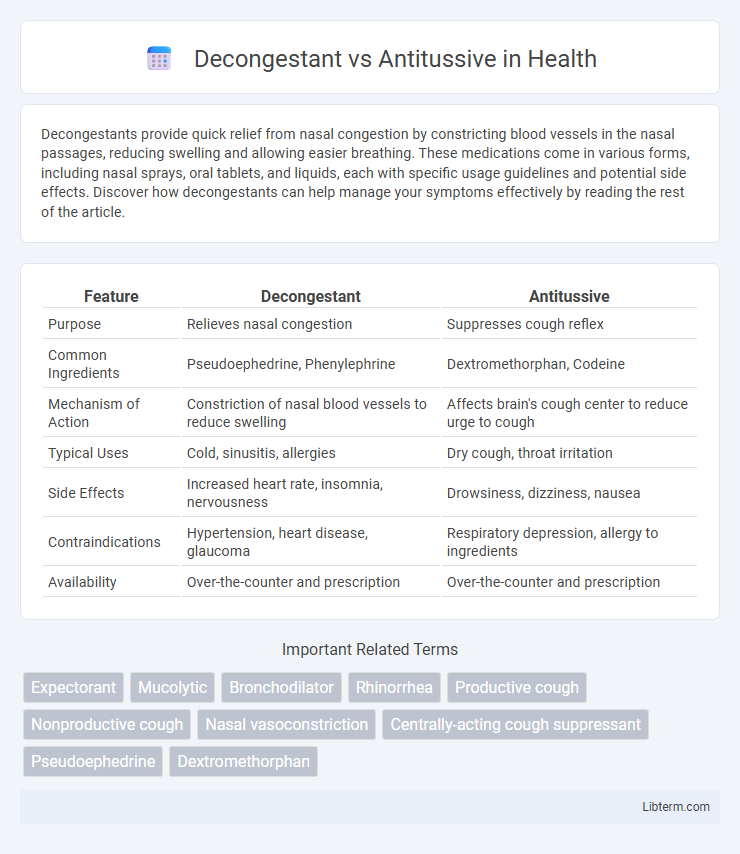Decongestants provide quick relief from nasal congestion by constricting blood vessels in the nasal passages, reducing swelling and allowing easier breathing. These medications come in various forms, including nasal sprays, oral tablets, and liquids, each with specific usage guidelines and potential side effects. Discover how decongestants can help manage your symptoms effectively by reading the rest of the article.
Table of Comparison
| Feature | Decongestant | Antitussive |
|---|---|---|
| Purpose | Relieves nasal congestion | Suppresses cough reflex |
| Common Ingredients | Pseudoephedrine, Phenylephrine | Dextromethorphan, Codeine |
| Mechanism of Action | Constriction of nasal blood vessels to reduce swelling | Affects brain's cough center to reduce urge to cough |
| Typical Uses | Cold, sinusitis, allergies | Dry cough, throat irritation |
| Side Effects | Increased heart rate, insomnia, nervousness | Drowsiness, dizziness, nausea |
| Contraindications | Hypertension, heart disease, glaucoma | Respiratory depression, allergy to ingredients |
| Availability | Over-the-counter and prescription | Over-the-counter and prescription |
Understanding Decongestants: Purpose and Function
Decongestants primarily relieve nasal congestion by constricting blood vessels in the nasal passages, reducing swelling and mucus production. Common active ingredients include pseudoephedrine and phenylephrine, which target symptoms of colds, allergies, and sinus infections. These medications improve airflow, making breathing easier without suppressing the cough reflex as antitussives do.
Antitussives Explained: What They Do
Antitussives are medications specifically designed to suppress coughing by acting on the brain's cough center, reducing the urge to cough without addressing nasal congestion. Common active ingredients in antitussives include dextromethorphan and codeine, which alter the cough reflex and provide symptomatic relief for persistent, dry coughs. Unlike decongestants that target nasal passages and sinus tissues to alleviate congestion, antitussives primarily focus on controlling cough symptoms to improve comfort and sleep quality.
Key Differences Between Decongestants and Antitussives
Decongestants primarily target nasal congestion by constricting blood vessels in the nasal passages, reducing swelling and improving airflow, while antitussives suppress the cough reflex to alleviate coughing. Decongestants are commonly used in conditions like sinusitis and allergic rhinitis, whereas antitussives are employed to manage persistent dry coughs. The key difference lies in their mechanism of action: decongestants relieve nasal blockage, and antitussives reduce the urge to cough.
Common Ingredients in Decongestant Medications
Common ingredients in decongestant medications include pseudoephedrine and phenylephrine, both of which constrict blood vessels in the nasal passages to reduce swelling and congestion. These active compounds target nasal congestion by shrinking swollen tissues and improving airflow. Unlike antitussives, which suppress the cough reflex, decongestants primarily focus on relieving nasal blockage caused by colds, allergies, or sinus infections.
Popular Antitussive Compounds and Their Uses
Popular antitussive compounds include dextromethorphan, which effectively suppresses dry cough by acting on the cough center in the brain, and codeine, a narcotic derivative used for severe cough relief. Benzonatate is another widely used antitussive, providing local anesthetic effects on respiratory stretch receptors to reduce coughing. These compounds are primarily employed to manage nonproductive coughs, improving patient comfort without addressing underlying congestion, differentiating them from decongestants that target nasal and sinus swelling.
When to Use a Decongestant vs Antitussive
Decongestants are best used for relieving nasal congestion caused by colds, allergies, or sinus infections by shrinking swollen blood vessels and tissues in the nasal passages. Antitussives are intended for suppressing dry, non-productive coughs that irritate the throat and disrupt sleep, often due to viral infections or irritants. Choosing between them depends on symptoms: use decongestants for blocked nose and antitussives for persistent cough without mucus production.
Potential Side Effects and Safety Precautions
Decongestants can cause side effects such as increased blood pressure, insomnia, and nervousness, making them unsuitable for individuals with hypertension or heart conditions. Antitussives often lead to drowsiness, dizziness, or gastrointestinal discomfort, requiring caution when operating machinery or driving. Both medications should be used according to prescribed dosages to avoid adverse reactions, and consulting a healthcare professional is essential for safe use, especially in children, pregnant women, or those with chronic illnesses.
Interactions with Other Medications
Decongestants such as pseudoephedrine can interact with monoamine oxidase inhibitors (MAOIs) and increase the risk of hypertensive crisis, while antitussives like dextromethorphan may lead to serotonin syndrome when combined with selective serotonin reuptake inhibitors (SSRIs) or other serotonergic drugs. Concurrent use of decongestants with beta-blockers or antihypertensives can reduce their effectiveness or cause elevated blood pressure. Antitussives should be used cautiously with central nervous system depressants, including alcohol and benzodiazepines, to avoid enhanced sedation and respiratory depression.
Choosing the Right Remedy for Cold and Cough
Choosing the right remedy for cold and cough depends on symptoms: decongestants effectively relieve nasal congestion by narrowing blood vessels in the nasal passages, while antitussives suppress cough reflexes to reduce coughing. Understanding that decongestants target blocked noses whereas antitussives address persistent cough helps tailor treatment to individual needs and improves symptom management. Proper selection ensures quicker relief and reduces discomfort associated with respiratory infections.
Tips for Safe and Effective Symptom Relief
Choose decongestants containing pseudoephedrine or phenylephrine to reduce nasal swelling safely by following dosage instructions and avoiding prolonged use to prevent rebound congestion. Select antitussives with dextromethorphan for suppressing dry cough, ensuring to monitor for side effects like dizziness and avoiding combination with other serotonergic drugs. Consult healthcare providers before use, especially for children, pregnant women, or individuals with heart conditions, to ensure effective symptom relief without adverse interactions.
Decongestant Infographic

 libterm.com
libterm.com